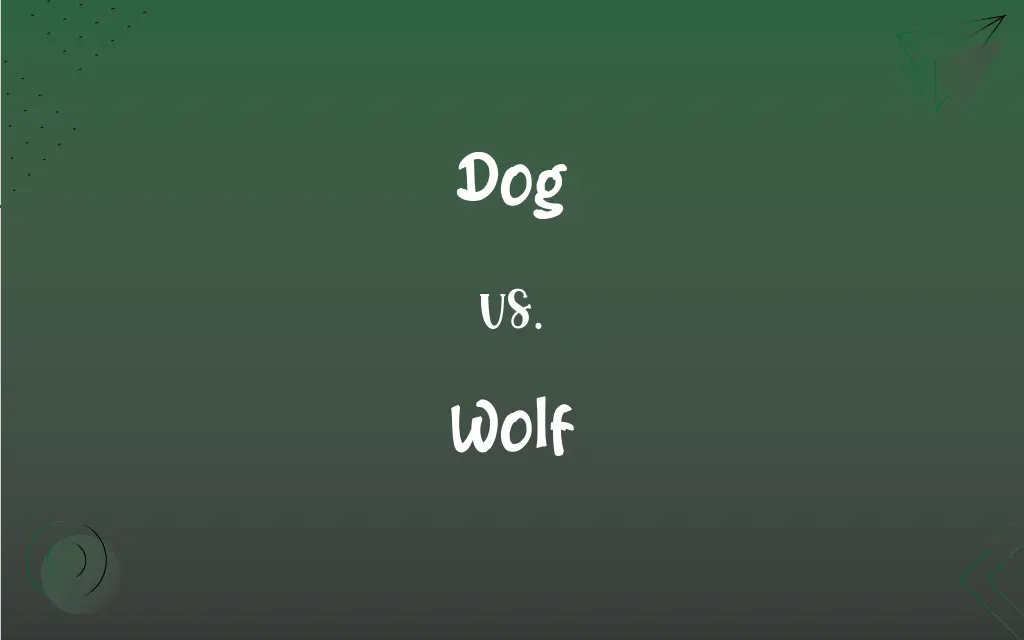Dog vs. Wolf: What's the Difference?
Edited by Aimie Carlson || By Harlon Moss || Updated on October 25, 2023
A dog is a domesticated pet descended from wolves, while a wolf is a wild carnivorous mammal.

Key Differences
Dogs and wolves, though closely related, represent distinct evolutionary paths and relationships with humans. Dogs are domesticated descendants of wolves and have been selectively bred over thousands of years to exhibit specific traits. Wolves, in contrast, are wild animals that have not undergone such selective breeding by humans.
Wolves are known for their pack behavior, with intricate social structures and roles within the pack. Dogs, having been domesticated, often look to humans as their "pack" and exhibit loyalty and obedience to their human owners. Yet, many domesticated dogs retain pack behaviors, especially when interacting with other dogs.
Physically, dogs can vary widely in size, shape, and color due to the extensive breeding by humans. From Chihuahuas to Great Danes, the diversity in dog breeds is vast. Wolves, on the other hand, have a more standardized appearance, typically with a larger body, longer legs, and a broader skull than most dogs.
One of the most marked differences between dogs and wolves is their interaction with humans. Dogs are often seen as family members, providing companionship and even working alongside humans. Wolves, however, have historically been seen as competitors or threats, leading to tensions and conflicts with human communities.
Comparison Chart
Domestication
Domesticated
Wild
ADVERTISEMENT
Variation in Appearance
Wide range due to selective breeding
Standardized appearance
Behavior with Humans
Often affectionate and loyal
Generally wary or aggressive
Social Structure
Can see humans as their "pack"
Complex pack hierarchies
Diet
Varied, often includes commercial pet food
Primarily carnivorous, hunting in packs
Dog and Wolf Definitions
Dog
A domesticated mammal bred for various purposes.
The dog wagged its tail excitedly when it saw its owner.
ADVERTISEMENT
Wolf
Often symbolizes freedom, wilderness, and instinct.
The spirit of the wolf is celebrated in many cultures.
Dog
Often trained to perform specific tasks.
The police use a dog for search and rescue missions.
Wolf
A wild carnivorous mammal known for pack behavior.
The wolf howled under the full moon, signaling to its pack.
Dog
Canines varying in size, breed, and function.
The dog show featured breeds from all over the world.
Wolf
A canine that has not been domesticated.
Unlike dogs, a wolf remains a creature of the wild.
Dog
Man's loyal companion for thousands of years.
The bond between a man and his dog is truly special.
Wolf
Has a complex social hierarchy within packs.
The alpha wolf led its pack with authority and strength.
Dog
An animal known for its sense of loyalty.
The dog waited every day at the door for its owner to return.
Wolf
Known for its hunting prowess and keen senses.
The wolf tracked its prey silently through the forest.
Dog
A domesticated carnivorous mammal (Canis familiaris syn. Canis lupus subsp. familiaris) occurring as a wide variety of breeds, many of which are traditionally used for hunting, herding, drawing sleds, and other tasks, and are kept as pets.
Wolf
Any of several carnivorous mammals of the genus Canis, especially the gray wolf of northern regions, that typically live and hunt in packs.
FAQs
Are wolves dangerous to humans?
While generally wary of humans, wild wolves can be dangerous if threatened.
How did wolves evolve into dogs?
Through thousands of years of selective breeding and domestication by humans.
Are dogs descended from wolves?
Yes, dogs are domesticated descendants of wolves.
Are wolves endangered?
Some wolf species or subspecies are endangered, but not all.
Can dogs and wolves interbreed?
Yes, they can produce viable offspring called wolfdogs.
Do all dogs have pack instincts like wolves?
Many dogs retain pack behaviors, but domestication and breeding have influenced their social structures.
Why do dogs come in so many sizes?
Selective breeding by humans has led to the vast range in dog sizes and appearances.
How many wolf species are there?
There are several species and subspecies of wolves, such as the gray wolf and the red wolf.
Can dogs and wolves communicate?
While they have common ancestors and some shared behaviors, their methods of communication can differ.
Why are there so many dog breeds but only a few wolf species?
Dogs have been selectively bred by humans for specific traits, leading to diverse breeds.
Why are dogs often called "man's best friend"?
Dogs have a long history of companionship, loyalty, and service to humans.
Are there places where dogs and wolves coexist?
Yes, in some regions, wild wolves and domestic dogs can be found in proximity.
Is it legal to own a wolfdog?
Laws vary by location; some places allow wolfdog ownership, while others prohibit it.
Can you domesticate a wolf like a dog?
No, wolves remain wild animals and don't exhibit the domesticated traits of dogs.
Can a dog eat a wolf's diet?
Wolves have a primarily carnivorous diet, which some dogs can eat, but domesticated dogs often have varied diets.
Are all dog breeds related to a specific kind of wolf?
All domestic dogs are descended from wolves, but not necessarily one specific kind.
Why do dogs bark but wolves rarely do?
Barking in dogs has evolved as a form of communication with humans, while wolves use other vocalizations.
Why do wolves howl?
Wolves howl to communicate with pack members, mark territory, and signal other wolves.
What's the lifespan of a dog vs. a wolf?
Dogs typically live 10-15 years, while wolves in the wild live 6-8 years on average.
Can you train a wolf like you train a dog?
Wolves can be conditioned to certain behaviors, but they don't respond to training like domesticated dogs.
About Author
Written by
Harlon MossHarlon is a seasoned quality moderator and accomplished content writer for Difference Wiki. An alumnus of the prestigious University of California, he earned his degree in Computer Science. Leveraging his academic background, Harlon brings a meticulous and informed perspective to his work, ensuring content accuracy and excellence.
Edited by
Aimie CarlsonAimie Carlson, holding a master's degree in English literature, is a fervent English language enthusiast. She lends her writing talents to Difference Wiki, a prominent website that specializes in comparisons, offering readers insightful analyses that both captivate and inform.































































